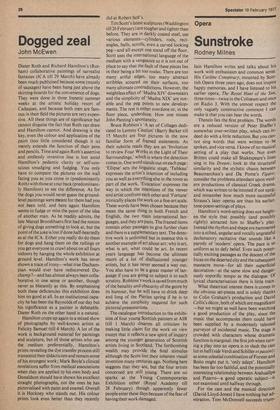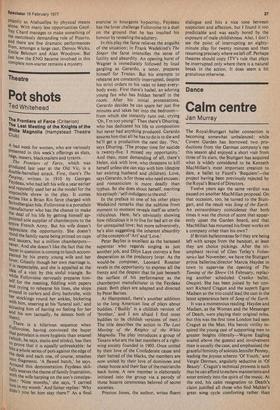Opera
Sunstroke
Rodney Milnes
lain Hamilton writes and talks about his work with enthusiasm and common sense. His Catiline Conspiracy, mounted by Scottish Opera three years ago, does not inspire happy memories, and 1 have listened to his earlier opera, The Royal Hunt of the Sun, three times—twice in the Coliseum and once on Radio 3. With the utmost respect the only vaguely constructive comment I can make is that you can hear the words.
Therein lies the first problem. The words are a reduced version of Peter Shaffer's somewhat over-written play, which can indeed do with a little reduction. But you cannot sing words that were written to be spoken, and vice versa. I know of no musical. setting of a play that works. Not even Britten could make all Shakespeare's lines sing in his Dream; look at the structural similarity and the stylistic chasm between Beaumarchais's and Da Ponte's Figaro; consider the problems attendant upon modern productions of classical Greek drama, which was written to be intoned if not sung; and remember how much more successful Strauss's later operas are than his earlier, tone-poem-settings of plays.
Hamilton's word-setting does not heighten the style that possibly (and possibly rightly) attracted him to Shaffer's play. Instead the rhythm and shape are hammered into a stilted, angular and vocally ungrateful declamatory recitative that sounds like a parody of 'modern' opera. The pace is so uniform as to defy belief. Even such potentially exciting passages as the descent of the Incas on the deserted city and the subsequent massacre move—for all their superficial decoration—at the same slow and dangerously soporific tempo as the dialogue. Of lyrical characterisation there is little trace.
What theatrical interest there is comes in the obvious set-pieces and is solely thanks to Colin Graham's production and David Collis's decor, both of which are magnificent —but we might as well have been watching a good production of the play, since the music that accompanies them could have been supplied by a moderately talented purveyor of incidental music. The stage is crowded with characters whose dramatic function is marginal: the first job when turning a play into an opera is to slash the cast list in half (vide Verdi and Schiller et passim); as some celestial combination of Forster and Boito might put it, 'only adapt'. Hamilton has been far too faithful, and the potentiallY interesting relationship between AtahuallPa and Pizarro—a good operatic subject—is not examined until halfway through.
For the cast . and the musical direction (David Lloyd-Jones) I have nothing but admiration. Tom McDonnell succeeds triurn
Phantly as Atahuallpa by physical means alone. With many less opportunities Geoffrey Chard manages to make something of the mercilessly demanding role of Pizarro, and there are fine dramatic performances from, amongst a large cast, Dennis Wicks, ErmIe Belcourt and Alan Woodrow. But Just how the ENO became involved in this complete non-starter remains a mystery.



































 Previous page
Previous page